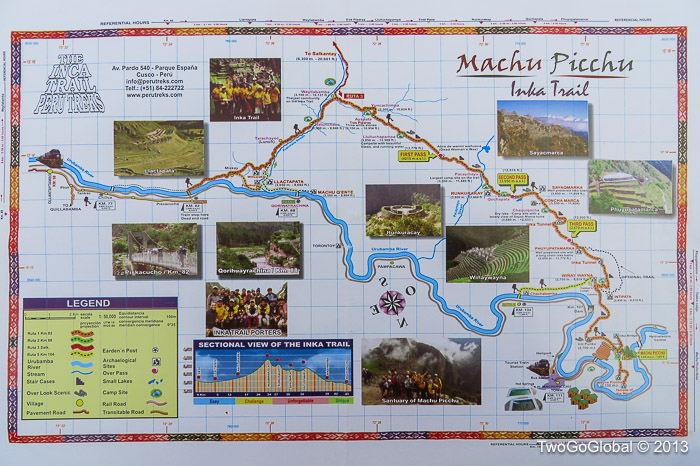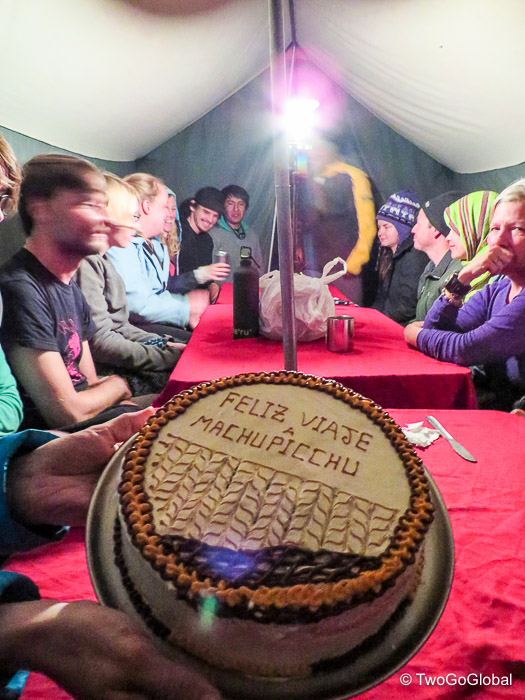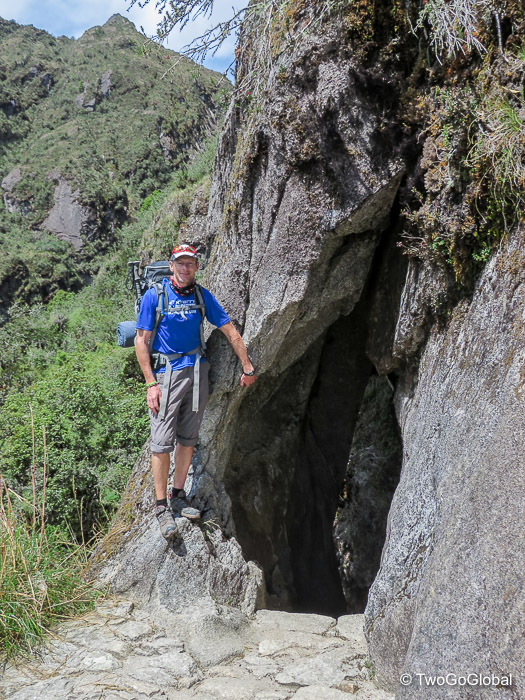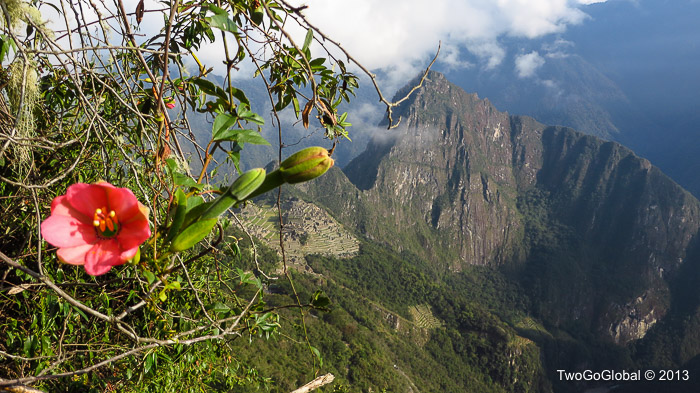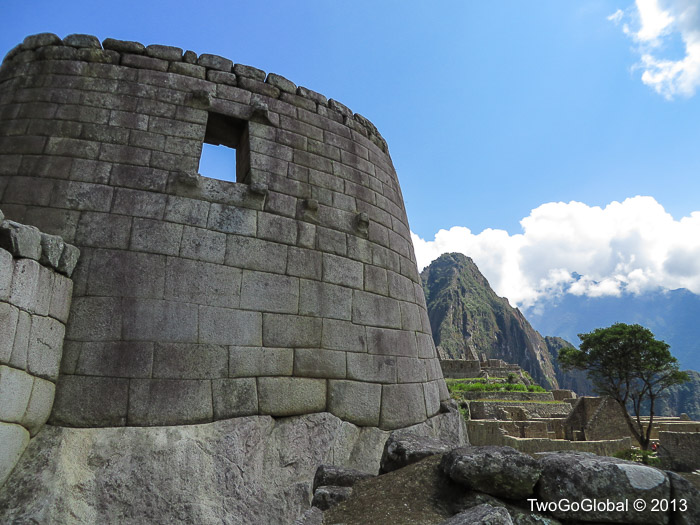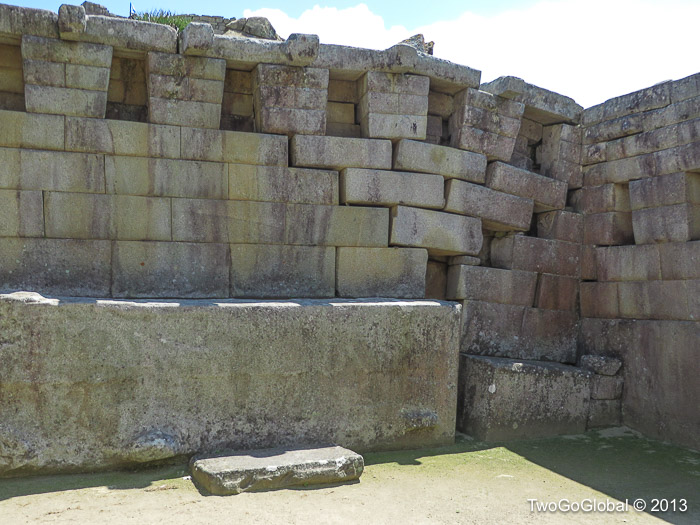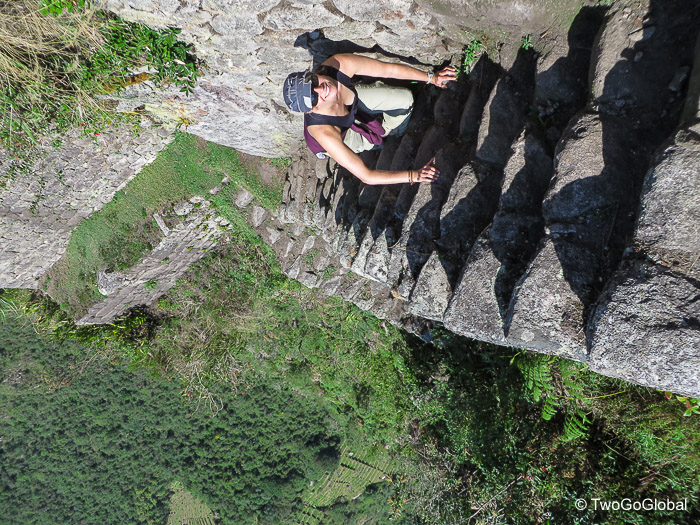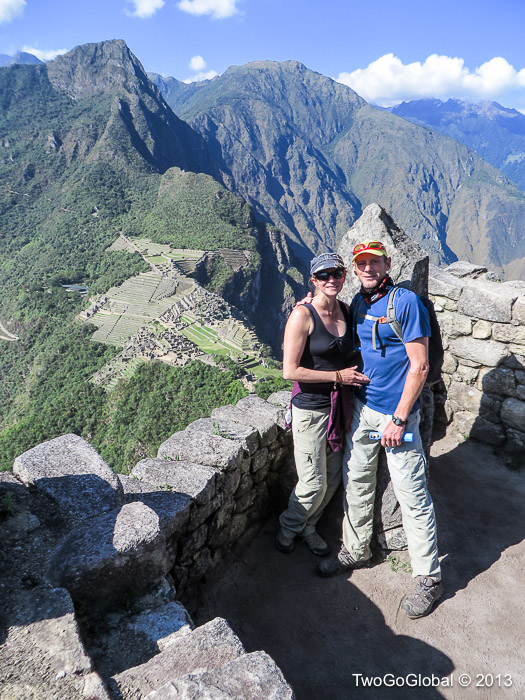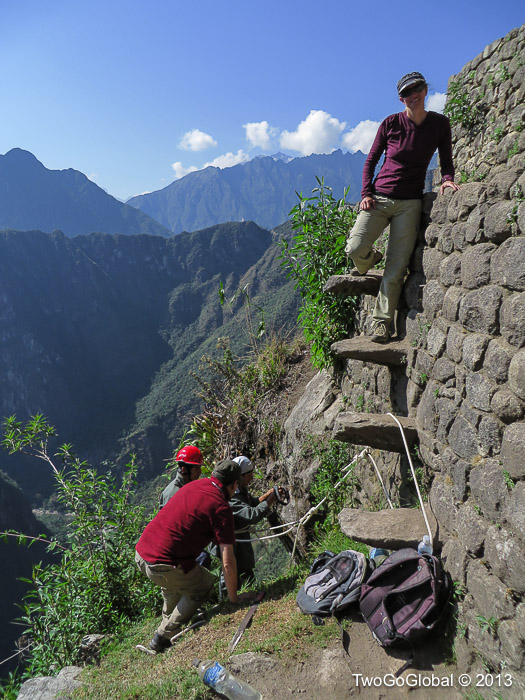The Inca Trail is probably one of the most famous four day treks in the world. That being said, the Peruvian government has now imposed limits on how many hikers and porters it will allow to start every day – about 200 hikers and 300 porters. Wayne and I had to make our reservations in April for our September 4th departure because we needed our trip to be part of Labor Day week for my work.
There are various ways to get to Machu Picchu, declared a UNESCO World Heritage Site in 1981, including the train, a five day Salkantay trek, and other hikes but we are extremely glad that we used Peru Treks and hiked the four day Inca Trail. We also decided to add on the Huayna Picchu hike which included a second day entry into Machu Picchu, and again it’s limited to two hundred people from 7-8am and another two hundred from 10-11am.
Day 1 – Km 82 to Wayllabamba
We were collected at our hotel at 5.30am and along with fourteen other trekkers, our guides, Saul and Darwin, and a few of the twenty one porters, we headed along the Sacred Valley for an hour and a half bus ride to Ollantaytambo for breakfast. Our only disappointment regarding Peru Treks was this choice of restaurant – the breakfast was cold and very bland, and fortunately not included in the trek cost otherwise we’d have been complaining from the first day! Everything that was included in the trek was spot on. Back on the bus for another thirty minute drive along the Sacred Valley and we arrived at km 82 where the rest of our porters were waiting and the four day trek would begin.
Our gang was made up of Australians, Germans, English, Americans, Costa Ricans and a Canadian with everyone gelling from the start. It would not have been anywhere near as much fun otherwise. Wayne and I chose not to hire an additional porter for our personal gear, but Wayne promised he would carry my load if it were too much during the hardest part of Day 2. He needs the extra weight to slow him down and for his La Ruta training. Fortunately we had no problems with the weight of our packs even going up to the high point of 4.200 meters on day two.
Day One was my least favorite day – Saul kept stopping to show us ruins, including the cool looking Llactapata, and explain about the Sacred Valley which was great, but as soon as I got my rhythm, we were stopping again. Everyone was secretly complaining about all the stops! We finally made it to the 3.100 meter Wayllabamba camp at around 5pm and the porters were already there with our tents set up for the night – this would happen everyday thanks to our amazing porters! They are allowed to carry a maximum of 25kg (which is heavy!) I would see them running past me on the trail and I always felt like such a lightweight with my hiking poles and my measly 9kg pack (Andrea speaking!).
Light comes at 5.30am in southern Peru this time of year, and with it came our wake up call with either coffee or tea delivered to our tents. This didn’t mean we could laze around as thirty minutes later we had to be packed and in the communal tent for breakfast. By 7am we were on the trail towards Dean Woman’s Pass, the Inca trail high point at 4.215 meters, and the first of three passes. No Inca ruins today so we hiked at our own pace, only stopping at the top of the pass and for lunch, perfect. This was to be out highest campsite at 3.500 meters, with a small waterfall nearby and a view of the hike upwards the next day.
Day 3 – Pacaymayu to Wiñay Wayna
Another early morning and an instant climb to get the legs and heart in check. Today we had two passes, one straight out of camp and the other pretty insignificant before a supposed three thousand steps down into Wiñay Wayna, the location of our final nights camp. Half way to the top of the pass at 3.950 meters we passed through some of the days Inca ruins, and as always the architecture and location made us want to go back five hundred years and see the builders in action. Its mind blowing to see the size and accuracy of the blocks that make up the various rooms, terraces and temples.
At the top of our first pass we all gathered at a higher area to make an offering to Pachamama so as to ensure us safe passage though the mountains. This involved three coca leaves and a stone we had collected from the stream earlier – the three leaves were fanned out and after blowing through them into the direction of the four cardinal points – Machu Picchu, Salkantay, Puma and Veronica mountains we placed them on the ground under our stone, all whilst chanting a Quechuan phrase. We would definitely have good weather for Machu Picchu now!
Day 4 – Wiñay Wayna to Machu Picchu
A 3.30am wakeup call is not fun, although not quite as bad when you’re in bed barely after sunset the night before. We had to be at the control gate leading out of camp and onto the two hour trail to Machu Picchu by 5.30am. The Peruvian authorities are pretty strict on ensuring our Inca Trail / Machu Picchu permits were stamped at various checkpoints on the route, and this one was no exception with a long line of trekkers and their guides waiting. Our guides had done this over a hundred times before and new the routine by heart.
Not everyone gets to spend their last camp at Wiñay Wayna – if the trekking company doesn’t reserve a campsite early enough they get the honor of hiking for over five hours on the final day, missing sunrise and getting to enjoy larger crowds when they arrive at the Sun Gate and Machu Picchu. Peru Treks were on the ball and ensured that we would only have two hours to the Sun Gate where we would see Machu Picchu in all its glory. The weather today was as perfect as we’d had every other day with mild temperatures, even at such an early hour, and mostly blue sky. We arrived at Intipunku, or Sun Gate at 7.30am to the most amazing goose pimple inducing view.
We could see the whole of this spectacular Inca city with our following days destination, Huayna Picchu, and many other forest covered peaks looming high above. It’s hard to imagine what went into constructing this city and why the Incas chose this location. They chose well as the Spanish never got to destroy it like they did so much of the Incan empire when they arrived in the year 1534!
National Geographic Machu Picchu Article
Machu Picchu is tangible evidence of the urban Inca Empire at the peak of its power and achievement—a citadel of cut stone fit together without mortar so tightly that its cracks still can’t be penetrated by a knife blade.
The complex of palaces and plazas, temples and homes may have been built as a ceremonial site, a military stronghold, or a retreat for ruling elites—its dramatic location is certainly well suited for any of those purposes. The ruins lie on a high ridge, surrounded on three sides by the windy, turbulent Urubamba River some 2,000 feet (610 meters) below.
Scholars are still striving to uncover clues to the mysteries hidden here high in the eastern slopes of the Andes, covered with tropical forests of the upper Amazon Basin. Machu Picchu appears to lie at the center of a network of related sites and trails—and many landmarks both man-made and mountainous appear to align with astronomical events like the solstice sunset. The Inca had no written language, so they left no record of why they built the site or how they used it before it was abandoned in the early 16th century.
Landscape engineering skills are in strong evidence at Machu Picchu. The site’s buildings, walls, terraces, and ramps reclaim the steep mountainous terrain and make the city blend naturally into the rock escarpments on which it is situated. The 700-plus terraces preserved soil, promoted agriculture, and served as part of an extensive water-distribution system that conserved water and limited erosion on the steep slopes.
The Inca’s achievements and skills are all the more impressive in light of the knowledge they lacked. When Machu Picchu was built some 500 years ago the Inca had no iron, no steel, and no wheels. Their tremendous effort apparently benefited relatively few people—some experts maintain that fewer than a thousand individuals lived here.
In 1911 a Peruvian guide led Yale professor Hiram Bingham up a steep mountainside and into the history books as the first Western scholar to lay eyes on the “lost city” of Machu Picchu. While indigenous peoples knew of the site, Peru’s Spanish conquerors never did—a fact which aided Machu Picchu’s isolation, and preservation, over the centuries.
The gates to the ruins open at 6am with a huge daily influx of tourists coming up by bus from Machu Picchu Pueblo, situated half an hour of switchback driving away, and the only way to get to the ruins if you chose not to hike in. By the time we dropped off our backpacks and had a bite for breakfast it was like a zoo, with tour groups galore being guided in a multitude of languages. Our guide, Saul, did a great job of explaining everything about the huge complex and then left us to discover the nooks and crannies ourselves.
Day 5 – Huayna Picchu (without Peru Treks)
This is something Wayne was very keen to do so I went along with it even though I was afraid of the discomfort to follow in my knees! To start with we had to get hold of the tickets, something that must be done at least a week or more in advance due to only four hundred people being allowed up each day – the problem for us was that it was impossible to pay on the Peru Macchu Picchu website and Peru Treks would not acquire the tickets on our behalf (our only complaint about them). We ended up paying thirty percent extra to get the tickets through a different agency in Cusco.
We left for the overpriced bus from Machu Picchu Pueblo at 5.30am and were still a long way down the huge line of people waiting to get up to the ruins in time for the 6am opening. This happens every single day of the year and I can only imagine the money that is generated for Peru tourism. We had another stroll through the ruins before heading off to the entry of Huayna Picchu, with our entry being for the 7-8am timeframe. We were numbers 121 and 122 in a line of two hundred very slow moving people! The top, some 240 meters higher than the ruins supposedly has one of the classic views and given the weather we were excited to get to the top – within forty minutes we were admiring Machu Picchu from a very different position.
Observations:
1. Altitude – I was very concerned before we left because I’ve done a few hikes to 14.000 feet in the past and I’ve really struggled, but Wayne and I had been on the Bolivian Altiplano for about eight weeks and I was well adjusted to the altitude and it didn’t bother me at all.
2. Three Mountain Passes – The first pass was the hardest going up to almost 14.000 feet. Our guide broke it down into three sections – a forty five minute easy climb, then two hours of stairs (a second breakfast was served), then the last section which is two hours up with some stairs. After the summit, it’s two hours of downhill stairs. This sounded pretty daunting to someone who hadn’t done much cardio in the past year. However, it was much, much easier than expected. The first section was forty five minutes, but the other two sections only took us an hour each. Both were really hard, but when you are expecting another hour and you see the camp with food it’s a huge relief! The second pass was difficult because it was the first part of the hike on Day three and my legs weren’t ready to move yet and the third pass was a joke! I’m not sure we climbed much at all!!!
3. The Weather – The weather for our trek was fantastic – we couldn’t have asked for anything better. I thought I would be freezing at night, but I was never cold in the tent. During the day we had blue skies with a few scattered clouds which made for great pictures!
4. The Downhill stairs – On Day three we had to descend 3000 Inca steps. They are called Inca steps because they are very narrow for small feet. Downhill is the hardest part for me with my old, cartilage free knees. I was very glad to finish this day and get to camp. It was also the longest day around fifteen kilometers and most of it was downhill.
5. Highlight of the Trip – The best part of the trip for me was when we arrived at the Sun Gate and had our first view of Machu Picchu! It was a beautiful morning and we had been waiting three days to have this beautiful view. Everyone was hoping to get a great picture and I think Wayne took a few really good ones!
6. Peru Treks – Our guides were awesome and very knowledgeable. They always made sure that everyone felt part of the group and they did a great job encouraging trekkers in our group that were slower. Saul was the serious one and Darwin was his joker sidekick – together they made a great pair and it was the first time they had worked together – you never would have known. The porters and our cook were also perfect! We had excellent food the entire trip! Also, the entire Peru Treks organization should also be commended. They were very professional from the time we booked our trip in May until we finished the trek in September.
September 4th – September 8th 2013

